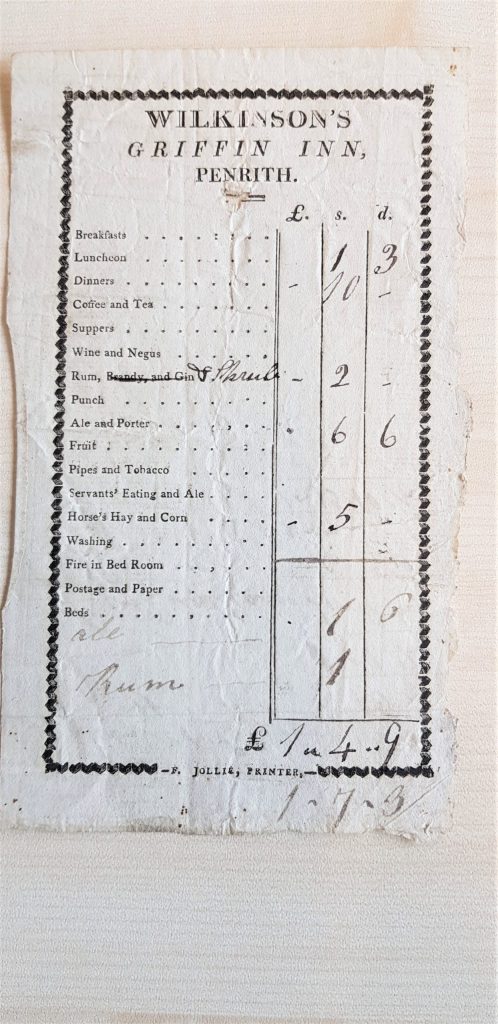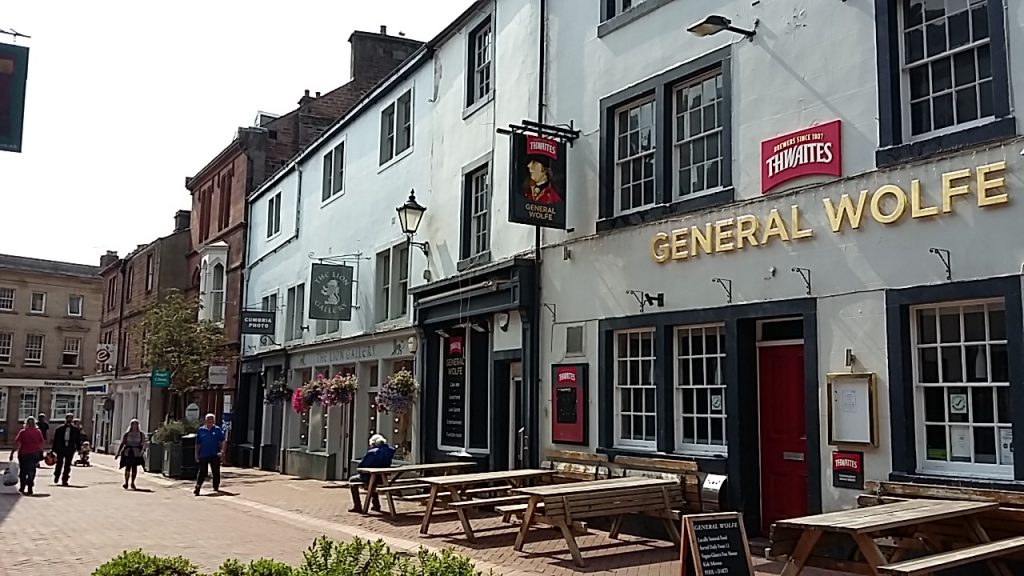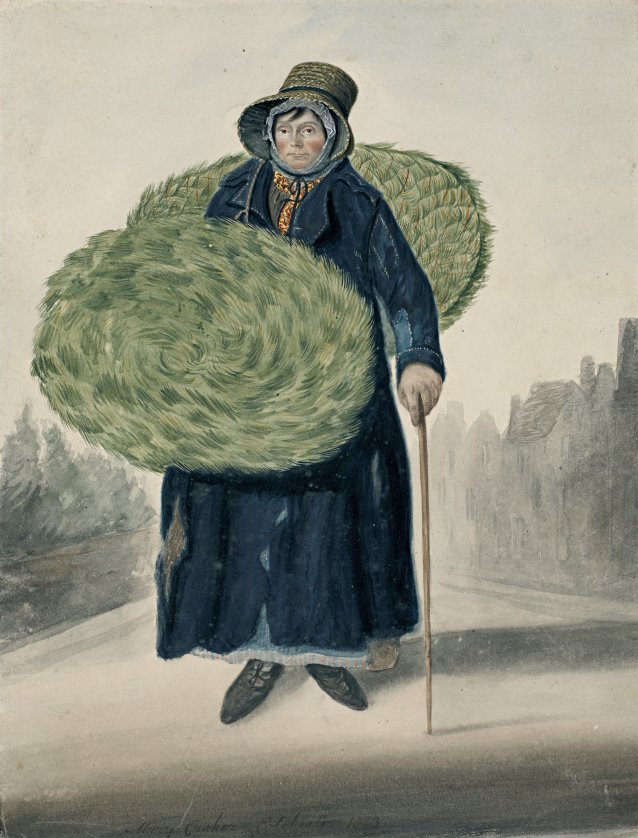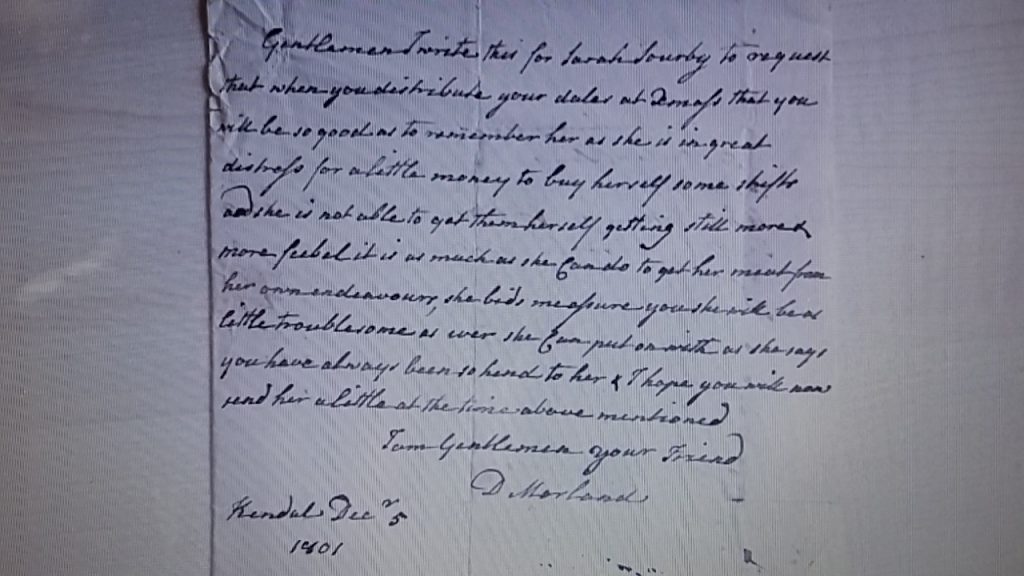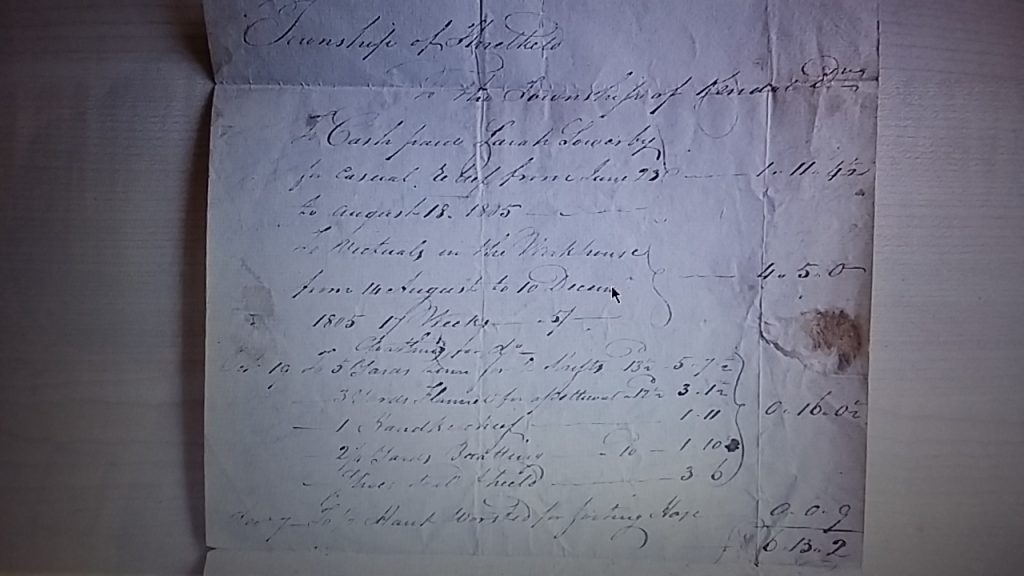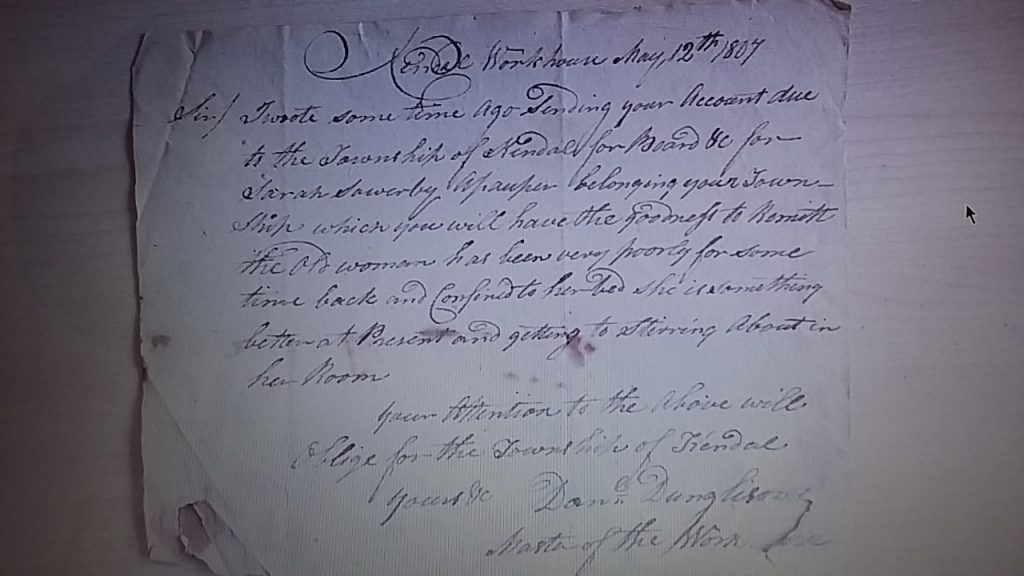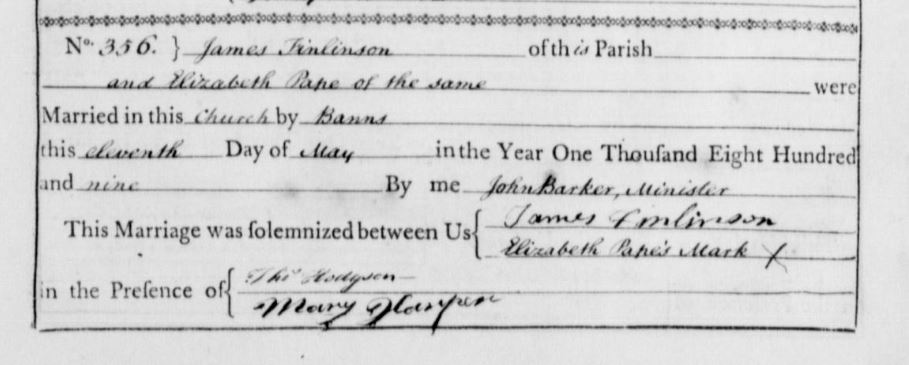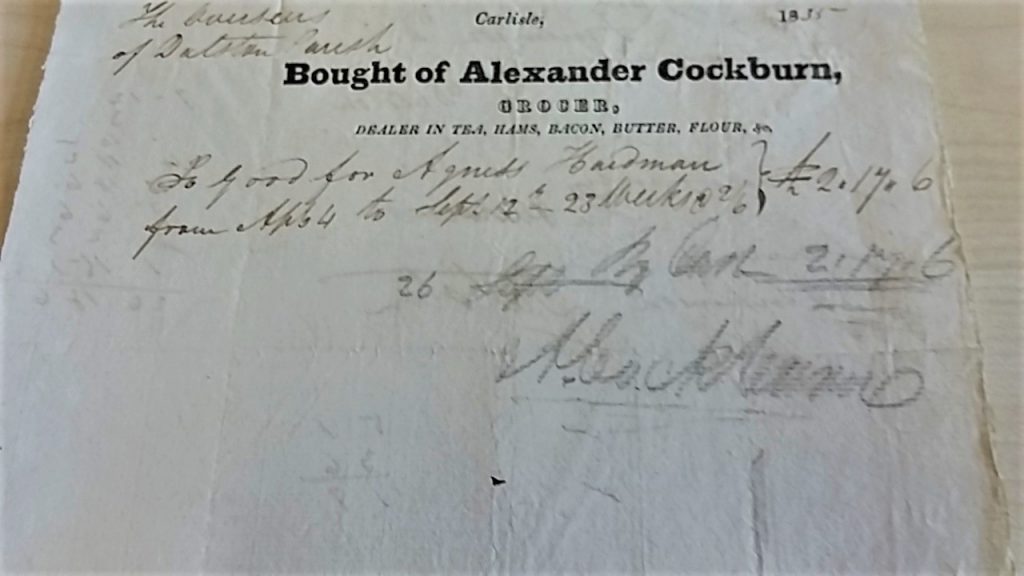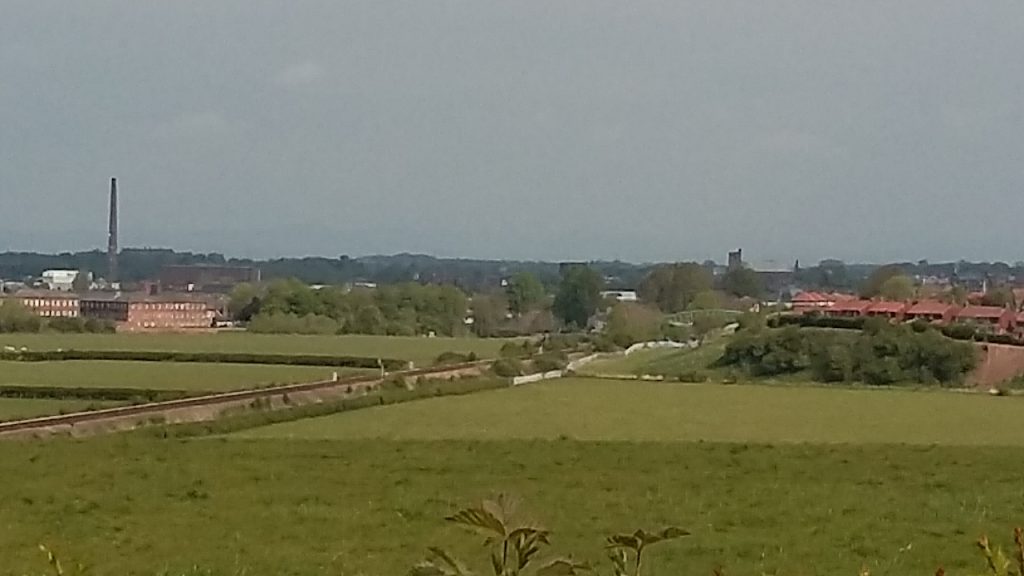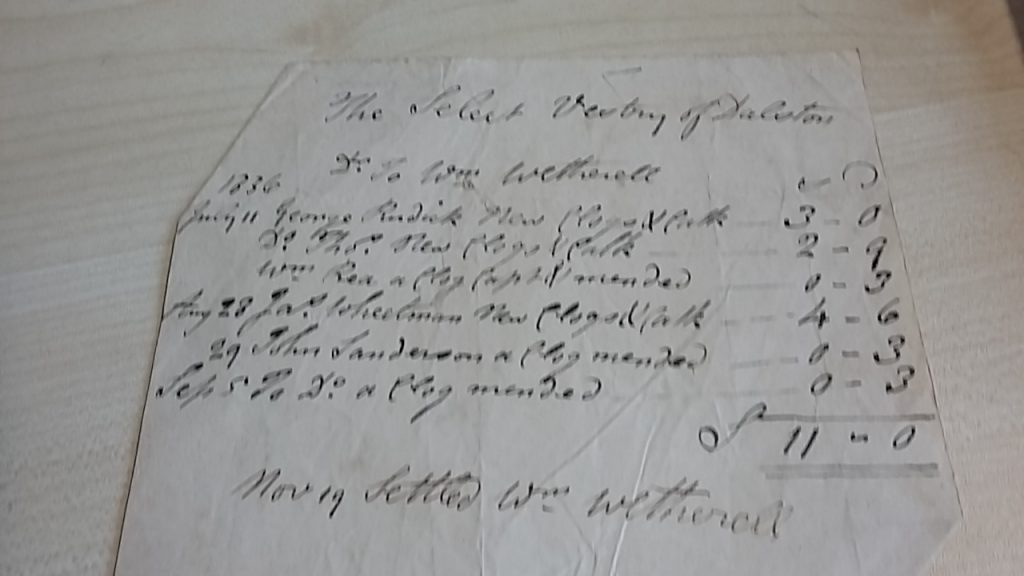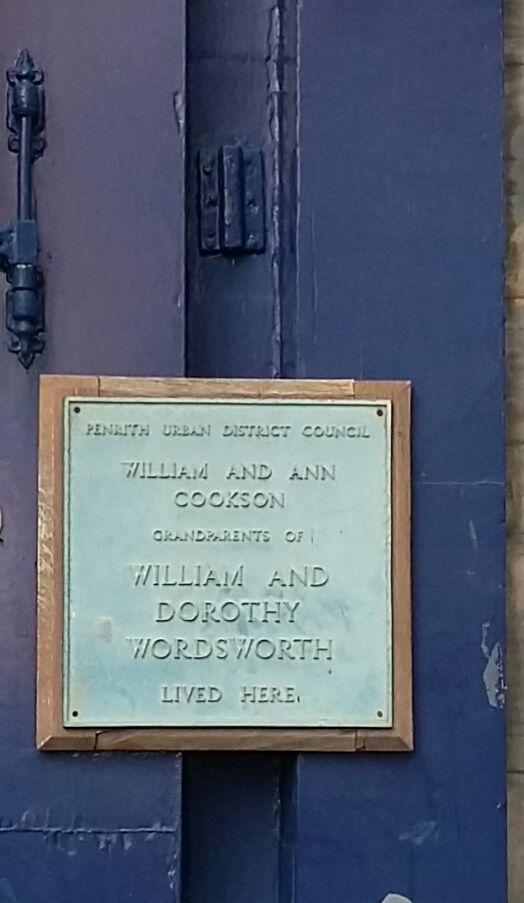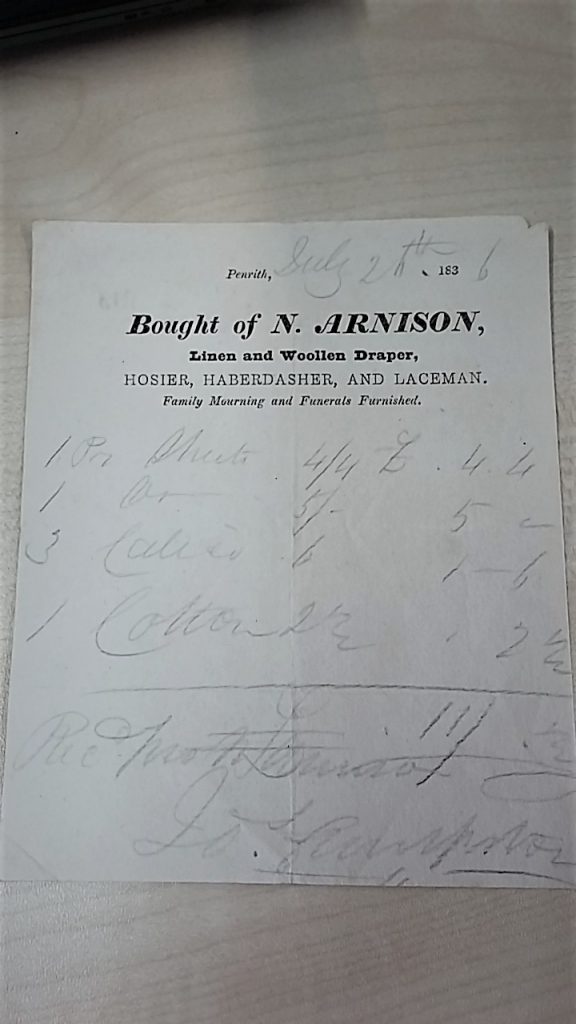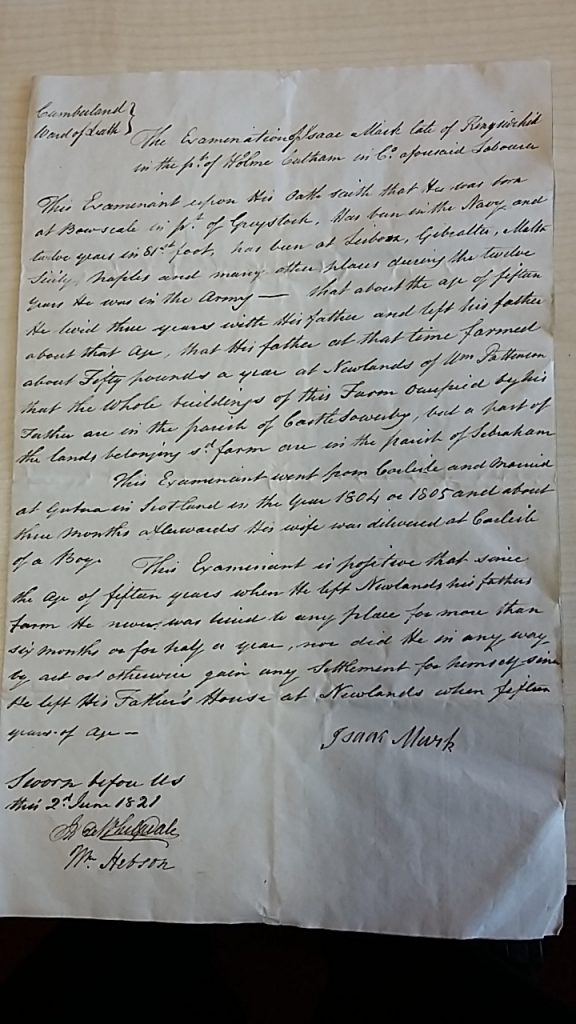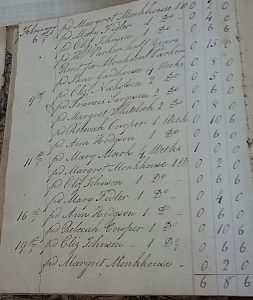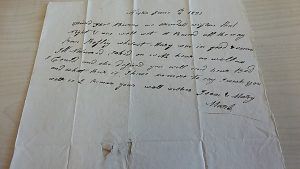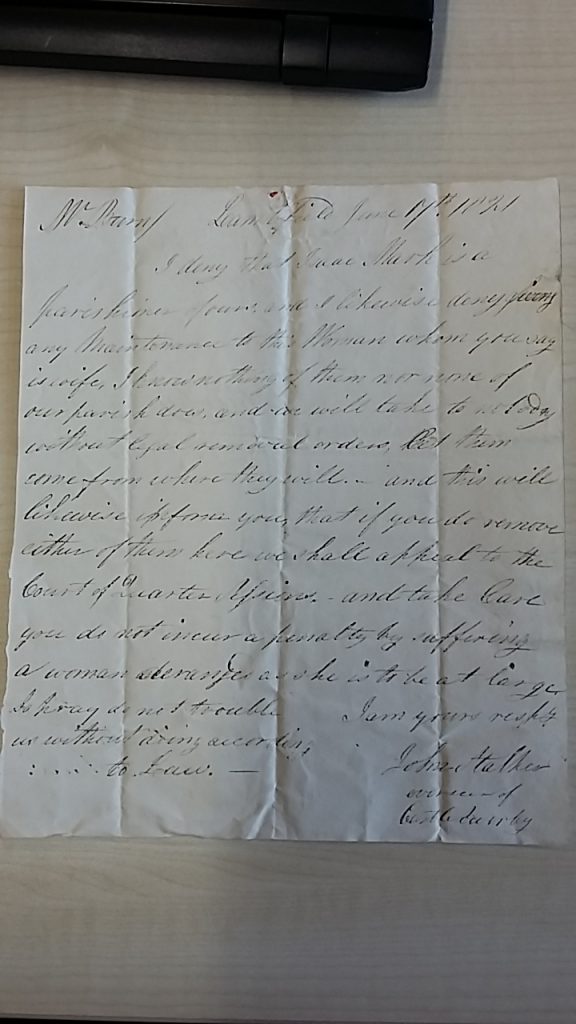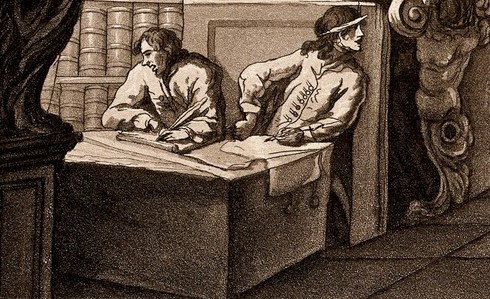Edward Heylin was a linen and woollen draper in Penrith. [1] Several vouchers appear with his name on them for the parish of Greystoke; some of which have a printed heading.[2] The bills were sent to Thomas Burn, overseer, and then assistant overseer of Greystoke. Most are bills of only a few lines long.[3] Around the time of these vouchers Heylin was also active in the community, being elected a churchwarden in Penrith.[4] As churchwarden it is likely he was influential in the distribution of Penrith’s charitable funds to the poor.
At least two of Heylin’s bills are for items for a Mary Johnson. Items supplied around 1822 include five yards of grey calico, at 3s. 9d; three yards black calico at 2s 3d; one yard of fustian at 1s; yarn and whalebone costing 2s 8d; two yds blue linen, thread and tape at 2s 6d; for the making of shifts, 8d, and two caps, 2d; two aprons, 2d, and a petticoat, 4d; the making of a pair of stays, 1s 4d. [5] The other bill cannot be positively dated but contains similar items. [6]
Mary Johnson was baptised in Greystoke in 1802 so she would have been around 21 when she received these items but her circumstances at the time are not known. She married Joseph Greenhow, a farm labourer, on 8 November 1830 in the same parish. By 1841 they were living at Hog House Brow, Martindale, with two children.
Edward Heylin’s father, also Edward (c.1772-1836), was a yeoman and owner of a farm at Celleron near Ullswater. His mother, Mary Wilkinson (c.1765-1841), owned property in Greystoke which had been in the family from the early eighteenth century. [7] Edward was baptised at Dacre, a village near Penrith, on 20 December 1801. He had three siblings: Jane (1794-1818) who married James Russell; John (1797-1854); and Margaret (1799-1877) who married Thomas Atkinson. Edward’s brother John also appears to have been a draper in Penrith around 1829 before becoming the Governor of Much Woolton Workhouse, Childwall, Lancashire. [8]
Edward married Maria Featherstonhaugh (1802-43) in Alston on 15 October 1823, her place of birth. Maria was descended from a branch of the Featherstonhaugh family of Featherstone Castle, near Haltwhistle, Northumberland. Edward was reputedly a direct descendant of Dr Peter Heylin (1599-1662), historian, author and chaplain to Charles I.[9]
Edward and Maria seem to have had a stable and well established life with a growing family but this was about to change. In 1839 Edward advertised for an apprentice in the Carlisle Patriot [10] but by late 1842 he was no longer trading in Penrith. The Carlisle Journal reported on 10 December 1842, that J. and J. Grindal had taken on his business. [11]
After his father’s [12] and mother’s deaths, he appears to have moved to London with wife Maria. It is unclear what precipitated this move.
1843 must have been a turbulent year for Edward Haylin. Despite favourable character references and their eldest son Richard Featherstonhaugh’s (1824-1852) position as a qualified solicitor, [13] second son Edward (1826-1855) was found guilty of a crime in April 1843. Edward, aged 17, having recently been appointed by Lord Lowther as a clerk at the General Post Office in London [14] was accused of stealing letters containing sovereigns from the Post Office General. [15] Considered a serious offence for which the death penalty had just been abolished in 1837, he was brought before the central criminal court on 8 May 1843. After some deliberation the punishment of the justice system was brought to bear. He was sentenced to transportation for life; departing for Norfolk Island, Australia, from Plymouth on 26 August 1843.
Edward Heylin’s youngest son Henry ( 1843-1899) was baptised at Clerkenwell, London, the month before Edward’s transportation. On 30 November 1843 his wife Maria died. Her death was recorded in Clerkenwell, aged 41.[16].
Son Edward never returned home. On 6 June 1855 he was found guilty of robbery and the illegal discharge of a firearm intending to cause harm and was executed on 26 June 1855. Considered by some as being a harsh punishment.[17] Whether his family knew of his fate is unknown.
From 1843 Edward Heylin the elder is difficult to trace. He occasionally appears on a list of those attending a meeting in London of the Cumberland Benevolent Institution [18] but it is difficult to say conclusively if this is him. He may have returned to Penrith occasionally being involved in the sale of family properties at Celleron and Penruddock but this cannot be confirmed without further research. [19]
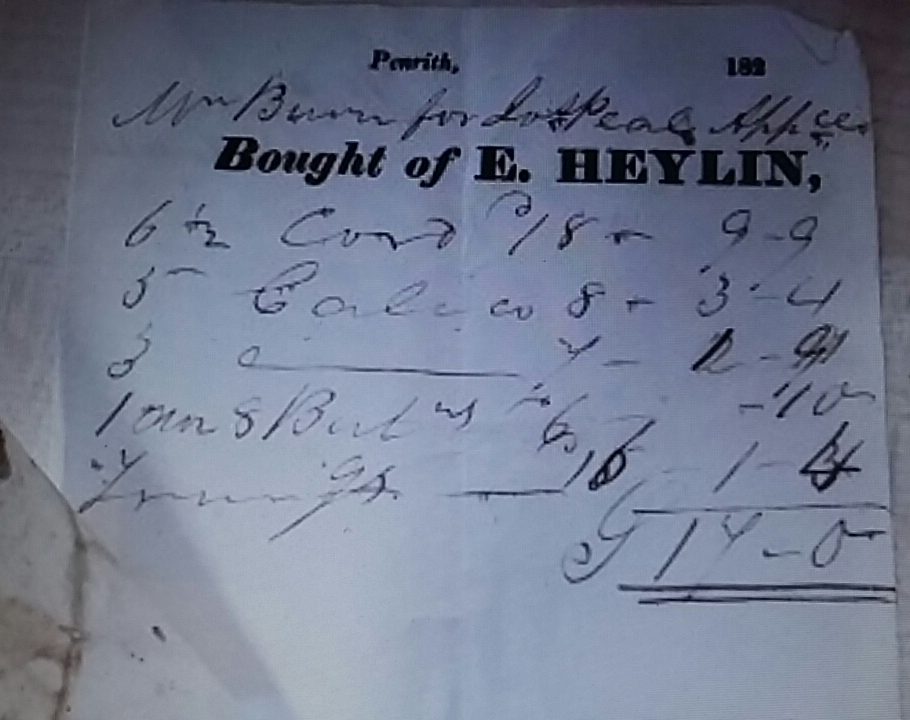
Additional information about other children of Edward and Mary Heylin.
Alexander (1829-1868) was a bookseller in London. A fire in 1861 at his business in Paternoster Row, was followed by bankruptcy in 1863. [20] Third son John died in infancy in Penrith (1833-1837). Emma (1835-1916) was described as a governess on one census and can be found living with her unmarried brother Henry (1843-1899) who she was caring for when he died aged 55 in 1899. [21] Maria (1837) married Francesco del Campo in 1872. Her whereabouts cannot be traced after this. Genevieve Jane (1839-1884) married William S. Wicks, a stationer by trade. They also had their troubles. William petitioned for divorce on the grounds of her adultery in 1872. Ultimately staying together, Genevieve died after a short stay in Hoxton Lunatic Asylum in 1884.
Footnote
On 15 July 1812 the Public Ledger and Daily Advertiser recorded the suicide of an E. Heylin. [22]This seems to refer to Edward Heylin who was overseer [parish officer] in Penrith in 1811. It cannot be established conclusively how he is related to Edwin Haylin. Also at this time there was an affiliation for Edward Heylin of Celleron to appeal against. [23 ] it is possible the two events are related.
sources
[1] J. Pigot, National Commercial Directory 1828-9 (London: Pigot & Co., 1828)
[2] Cumbria Archives, Greystoke Overseers’ Vouchers, PR5/53 11, 183[?]
[3] Cumbria Archives, Greystoke Overseers’ Vouchers, PR5/54 19B 182[?]
[4] Westmorland Gazette, 5 July 1823, p.3, col. e
[5] Cumbria Archives, Greystoke Overseers’ Vouchers, PR5/67-D 11, 7 August 1821 or 2, bill for items for Mary Johnson
[6] Cumbria Archives, Greystoke Overseers’ Vouchers, PR5/67/D 8 [1820s]
[7] Liverpool Standard and General Commercial Advertiser, 6 August 1841 p. 8, col. e.
[8] TNA, HO/107/511/13 1841 Census, Much Woolton Workhouse, Childwall, Lancashire.
[9] Liverpool Standard and General Commercial Advertiser, 6 August 1841 p. 8, col. e.
[10]Carlisle Patriot, 16 February 1839, p. 2, col. a
[11]Carlisle Journal, 10 December 1842, p. 2, col. e
[12]Carlisle Journal, 10 September 1836, p. 3 col. g
[13] TNA, Court of King’s Bench: Plea Side: Affidavits of Due Execution of Articles of Clerkship, Series III; Class: KB 107; Piece: 16 [accessed at ancestry.co.uk 16 July 2020]
[14] Kendal Mercury, 6 May 1843, p. 2, col. g
[15] Old Bailey Proceedings Online (www.oldbaileyonline.org, version 8.0, 18 July 2020), May 1843, trial of EDWARD HEYLIN (t18430508-1417).
[16] Worcester Journal, 7 December 1843, p.3, col. f
[17] Libaries Tazmania Online Collections https://stors.tas.gov.au/CON33-1-76$init=CON33-1-76p85 and Colonial Times 27 June 1855 p. 2, col. f [accessed at trove.nla.gov.au] https://trove.nla.gov.au/newspaper/article/8781473?searchTerm=heylin
[18] Penrith Observer, 26 May 1868, p.6 col., c
[19] Cumbria Archives, DX 315/1, Deeds relating to property in Motherby, Penruddock Cumberland, and Barton, Westmorland, 1669-1859
[20] The Stirling Advertiser and Midland Counties Advertiser, 12 September 1861, p. 3, col. b; London Gazette, 31 July 1863, p. 3817
[21] West London Observer, 21 April 1899, p.6, col. d
[22] Public Ledger and Daily Advertiser, 15 July 1812, p.3, col, c
[23]Cumbria Archives, Kendal ,WQ/SR/651/23 Recognizance of Edward Heylin and John Bailey, 4 Jan. 1812 [accessed at www.ancestry.co.uk] England, Select Births and Christenings 1538-1975 , UK Lunacy Patient Admission Registers 1846-1912, England and Wales Civil Divorce Records 1858-1918
GRO search index www.gov.uk [deaths]
Thanks to Joe McDarby
